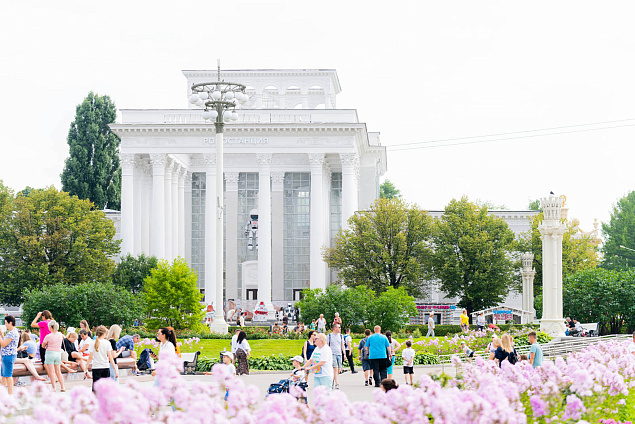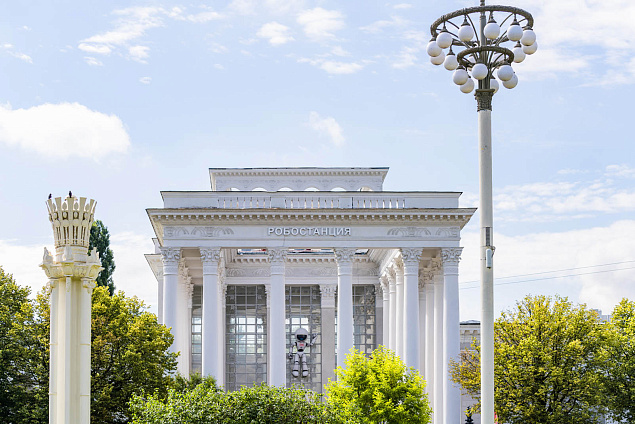Robostation. Pavilion No. 2, Popular Education (former the Pavilion of the North Caucasus)
The pavilion is open to the public. You can visit Robostation any day of the week, fr om 11:00 AM to 8:00 PM. Tickets are available on the website. The pavilion is currently admitting no more than 50 guests at a time.
The pavilion houses the interactive exhibition Robostation where you will find unique robots from South Korea, Japan, China, America, Europe and Russia, as well as learn about the latest trends in robotics.
At the Robostation, you can draw your robo-self-portrait, see the giant robofish, get a robo-fortune-telling, ask the I'm-so-smart robot some tricky questions, hear the latest robo-jokes, play basketball and table football with robots, put on a robot costume and try to score a goal against a robot goalkeeper.
They have a huge interactive play zone wh ere you can also celebrate your child's birthday.
Date of Construction, Author
The pavilion was built in 1954 based on a design by S. P. Polupanov.
Name Changes
Until 1959: North Caucasus; 1959–1963: Science; 1964–1966: Cosmos.
Status
Cultural heritage site of federal significance.
Current State
The façade of the pavilion is still undergoing conservation and restoration works.
Background
From 1939 to 1941, there was a Summer State Circus in place of today's Popular Education Pavilion at the All-Union Agricultural Exhibition. Later, it was replaced by a building resembling the lace-like architectural ensembles of the Russian South, the North Caucasus pavilion. Behind it was the Niva café, designed according to a standard design by the architect L. I. Marinovsky. Within the context of the Exhibition, the pavilion and the café were considered a single concept.
The architect S. P. Polupanov designed the building of the North Caucasus pavilion to be very lightweight and lace-like. The floor plan U-shaped, placed on a stylobate, it looks like it is soaring upward. The general concept of 'flying' is complemented by the elegant colonnade that forms a spacious outdoor hall in front of the entrance and by the tall windows. The cornices and capitals of columns are decorated with stucco floral ornamentation. The building is topped with a low open-work arcading that surrounds the monitor roof.
The sculptures Shepherd and The Kolkhoz Woman (by A. I. Tenet) used to stand in front of the side wings of the pavilion, which is also decorated with arcadings. They symbolised the growth of public cattle-breeding and the mechanisation of crop farming.
In 1993, the Popular Education pavilion got two new architectural elements: two cast-iron moulded vases. Previously, they used to decorate the niches of the Professional Technical Education pavilion, now lost.
Today, the Popular Education pavilion is one of the most vivid compositional elements on the Square of the People's Friendship.
History of Expositions
The first exposition in Pavilion No. 2 was called North Caucasus and Crimea. It occupied 2,300 sq. m. of exposition space and demonstrated the accomplishments of agriculture in the Rostov, Kamensk, Crimea and Grozny Regions, the Stavropol and Krasnodar Territories, and the Dagestan, Kabardino-Balkarian and North-Ossetian SSRs. However, when the RSFSR passed the Crimea Region to the Ukrainian SSR, the corresponding section of the exposition was moved to Pavilion No. 58.
The stands, dioramas and colourful wall panels of the central hall, decorated with a fountain, and the materials of the three halls surrounding it told guests of the All-Union Agricultural Exhibition about lands that produce abundant harvests of grain, rice and soy; lands of boundless gardens and vineyards, plantations of tomatoes, aubergines and peppers; lands of vast pastures, providing sustenance for vast flocks of sheep and herds of horses. The exposition also covered the rich mineral resources of the North Caucasus, such as oil, non-ferrous metals, coal, and covered the world-famous therapeutic mineral baths.
The patterns on the pavilion walls represented various crops typical of the region.
The key feature of that first exposition was a spacious sunroom with tall palm trees, fruit trees and flowers. The flower garden of the stylobate and another near the pavilion featured different flowers of the North Caucasus, too.
In 1959, the pavilion got a new name—Science. Now, its four halls accommodated the latest technology in the fields of computer science, microbiology, physics, chemistry and the pride of the Soviet science establishment—space exploration. At first, the separate space section occupied only the first hall, but in 1962, it spread to include the second hall of the pavilion. Here, one could see the first Soviet satellites, models of space rockets and the other latest designs in space exploration.
From 1959 to 1964, a part of the Estonian SSR exposition that hadn't found room in the nearby pavilion was housed in the greenhouse.
In May 1964, all sections of the exposition, except for the space exploration one, were moved to other buildings at VDNH USSR.
The current name, Popular Education, was given to Pavilion No. 2 in 1967. Back then, it displayed the accomplishments of Soviet education, divided into three big sections: Pre-School Education, General Education Schools, and Specialised Secondary Schools, combined with Higher Education Institutions.
In 1977, for the In a United Country exhibition organised to celebrate the 60th anniversary of the Revolution, the hall of Pavilion No. 2 accommodated the exposition of the Latvian SSR.
During a very difficult period for the Main Exhibition of the Country (the 1990s to the early 2000s), it was used as an embassy of the Republic of Georgia, the Museum of the USSR and even the House of Butterflies.
In 2014, restoration works at the Popular Education pavilion became a part of the programme for the renaissance of VDNH. Since the reconstruction, it has been housing the interactive exhibition Robostation.

